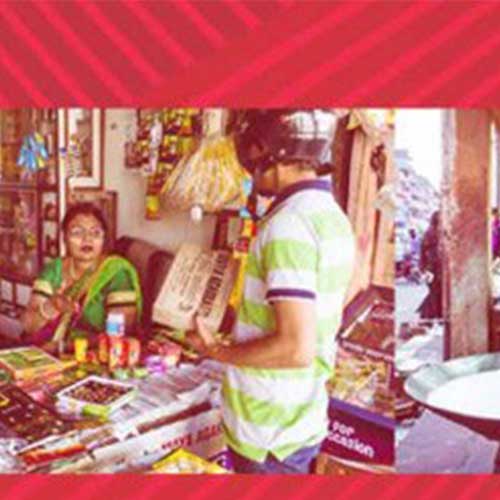 Kamal Singh, a 40-year-old tea vendor in the walled city area of Jaipur has been running his family’s tea shop for two generations. As we arrive, Kamal is busy serving tea and biscuits to office-goers who are sitting on a row in a small iron bench outside the shop. Rakesh Singh, his 70-year-old father, is mixing milk and tea in a burning aluminum vessel in a corner in the shop.
Kamal Singh, a 40-year-old tea vendor in the walled city area of Jaipur has been running his family’s tea shop for two generations. As we arrive, Kamal is busy serving tea and biscuits to office-goers who are sitting on a row in a small iron bench outside the shop. Rakesh Singh, his 70-year-old father, is mixing milk and tea in a burning aluminum vessel in a corner in the shop.
The visible inventory in the shop is scant – a couple of big glass jars filled with biscuits, a few packets of plastic tea cups and some freshly bought sachets of milk from the local diary. Early on in our conversation, Kamal tells us that he needs around one lakh rupees to expand his business. While he did apply for a loan from a formal financial institution, his application was rejected.
FINANCING THE ‘MISSING MIDDLE’
Millions of microentrepreneurs such as Kamal are unable to access working capital loans from banks and financial institutions due to lack of formal financial histories. In such a scenario, digitizing merchant payments generate data trails that can be used by a financial service provider to assess the credit worthiness of small merchants and extend loans.
As part of a pilot initiative to test this hypothesis, Catalyst has partnered with a financial service provider to provide a sample of small merchants with a Point of Sale (PoS) machine to digitize payments by customers. During the onboarding process for the pilot, we demonstrate the PoS machine to Kamal and help him with instructions on how to operate it. We also tell him that if he encourages his customers to pay by card even for small transactions – a lending agency will be able to see his monthly transaction data, and offer him a formal loan. Once a small ticket size loan is disbursed by the lender, the daily interest payment due on the loan can be deducted directly from the payments received from the card swipes at the POS. Kamal is intrigued by the proposition and seems convinced that using the POS machine can help him get a loan.
HIGH COSTS – A BARRIER TO GOING DIGITAL
Following the onboarding to the machine, we explain to Kamal the upfront cost and the rental cost of buying and maintaining a PoS machine. At this stage, we see a hesitation on Kamal’s face. The upfront cost of buying the machine is upwards of Rs. 2000 and he needs to pay an additional rental fee of Rs. 250 per month to maintain this machine. These costs are over and above the daily interest on the loan amount that he wishes to borrow.
“The cost of buying and renting the machine is quite high for me. It is also challenging to convince my customers to pay digitally for small transactions.”
Hearing about the various indirect costs associated with acquiring and using the PoS machine, Kamal’s interest in the loan product has visibly dwindled. Moreover, his customers undertake transactions of small ticket sizes and he is doubtful about nudging them to pay him digitally.
LEARNING BY ITERATING
Our conversations with Kamal gives us important insights into the operational challenges related to testing our hypotheses of bundling digital payments with credit propositions. We are back to the drawing board and are working on an iteration of the pilot.
In the next phase, we will introduce a no/low cost payment alternative for small merchants such as Unified Payments Interface (UPI) to help them overcome the cost barriers associated with purchasing and renting a PoS machine. Using our iterative design and learning process, we will also continue to gather deeper insights into the factors that influence merchants and the customer’s willingness to adopt digital payments for small transactions at retail shops such as the one run by Kamal and his family.








